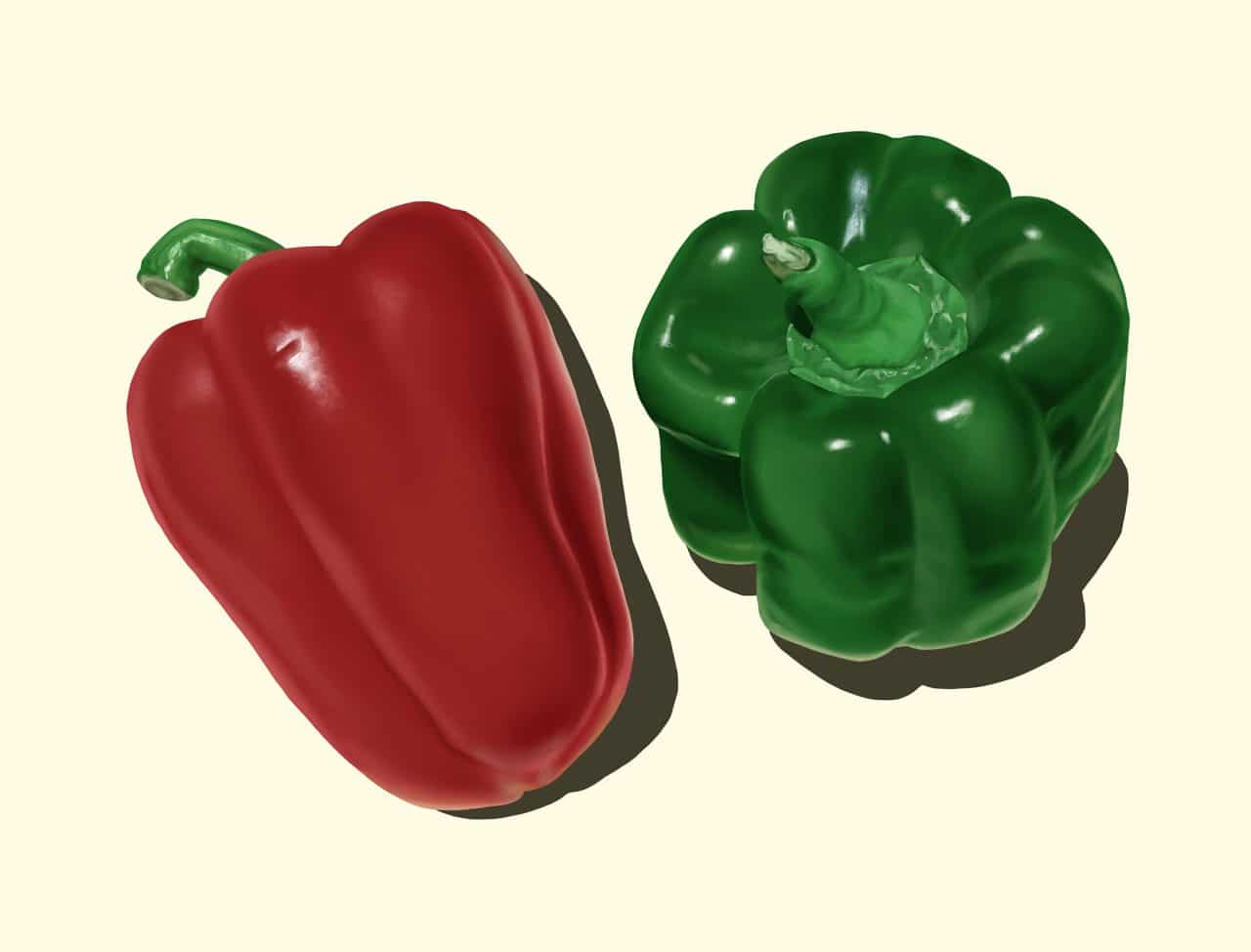Looking to perfect your still-life drawing game? This easy Procreate tutorial is here to help! Read along for a simple yet comprehensive step-by-step guide on how to draw croissants digitally using iPad Pro.
Digital drawing continues to thrive as an exciting medium in the world of art. Many famous illustrators have created truly remarkable work using Procreate on iPad Pro, and now it’s your turn to try out the amazing tools this artistic medium has to offer.
This realistic croissant drawing Procreate tutorial will break down the process of illustrating on a tablet and teach you the basics on how to use this amazing app. We’ll use how to draw a croissant as our example!
How to Draw Croissants: Drawing on iPad
I’m a Toronto illustrator who specializes in book illustration, portraiture, editorial illustration and exhibition design. Over the last few years the digital medium has become an important drawing tool for me and a integral part of my illustration process overall.
If you are new to digital drawing I am sure you’ll be amazed, both by how easy it is to pick it up, and by the new range of drawing potential it provides. Creating illustrations of everyday things around your home, like a delicious croissant, with an Apple Pencil on iPad Pro, allows for new and advantageous ways of creating layers, texture, and dimension, and is also really quite fun.

Croissant Drawing Procreate Tutorial
If there’s a food that needs no introduction, it’s a croissant. Obviously this assignment brought be great joy – seeking out the most visually appealing croissant I could find, drawing it, and then eating it. What a delight!
Deliciousness aside, a croissant is also a pretty interesting subject for a still life drawing. Still life drawing uses non-living, everyday objects that are good at holding still, as subjects to practice drawing techniques like light and shadow, colour, shape and texture. Food has long been a favourite subject for this very thing. And a croissant – smooth, yet also quite textured, delicate but structural – makes for an interesting set of challenges for a realistic drawing.
Luckily for you Procreate makes recreating telltale croissant characteristics in your drawing fun and easy. And this Procreate tutorial will break down the process into separate steps that will have you creating a scrumptious croissant masterpiece in no time.
Not to mention, the Procreate methods you’ll practice using in this tutorial will create the benefit of adding many exciting new tools to your art arsenal!
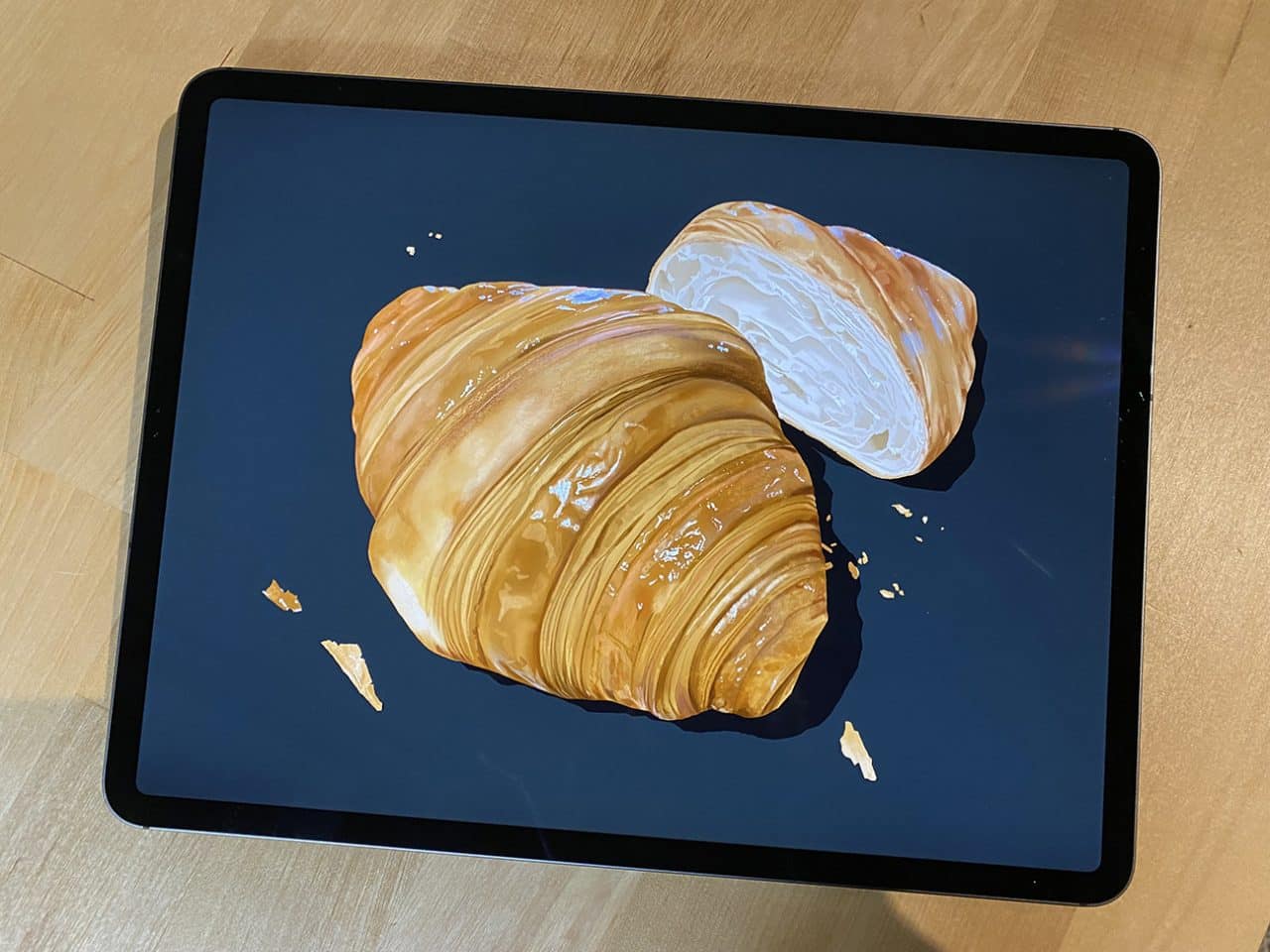
Procreate Tutorial: How to Draw A Croissant with iPad Pro
Let’s first get set up with a new canvas in Procreate. When you first open the app you’ll be in the “gallery” where all of your artworks will be visible. Tap the “+” in the top right of the screen and a menu will appear where you can select your canvas size.
To choose your dimensions click “create custom canvas” and enter them (in mm, cm, inches, or pixels). You can simply select “screen size,” however I recommend going bigger so that you have the option to print your finished piece with a nice resolution.
For my croissant drawing I’ve created an 11″ x 14.5″ canvas. I’ve gone with a resolution of 300 DPI, which allows for up to 35 layers. If you go too big the maximum number of layers you can have in your artwork can be too few for our purposes, this is a good size.
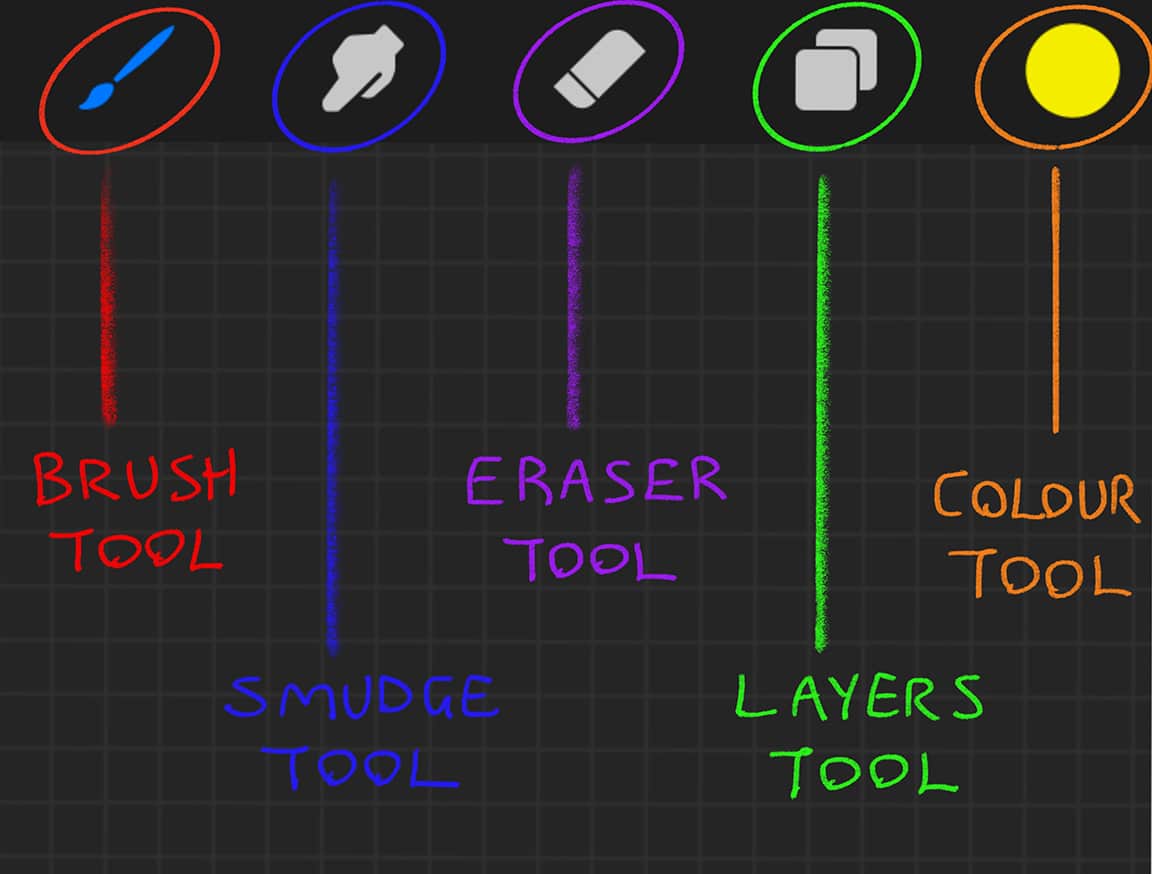
Now it’s important to explore and familiarize yourself with Procreate’s basic tools. Starting with the toolbar on the top right of your canvas.
- The Brush Tool: This is the tool with which you draw/paint. Tap it to open your Brush Library. Procreate’s brushes are categorized in a list down the left side of the drop down menu. Tap any of these to see your brush options in each category. Choose what you like and then tap the brush icon in the toolbar again to close the menu. Now get scribbling! Try a few different brushes and use different pressures and angles of the Apple Pencil – it’s remarkably realistic in its response to your hand.
- The Eraser Tool: It does exactly what you think it does! Tap it and you’ll open an identical Brush Library as tapping the brush tool. Try a few and see how it erases your scribbles.
- The Colour Tool: This is your colour palette. Tap and it will open in its default view of “Disc.” Use the outer wheel to select colour, and the inner circle to select lightness/darkness. Or you can use the square view that combines the two. When you’ve chosen the colour you want to use, tap the colour icon in the toolbar again to close the menu. Again, do some scribbling! Choose a variety of brush and colour combinations to get a feel for the colouring process.
- The Smudge Tool: This is used to blend colours and create gradients. This tool has the same effect as taking your finger to pencil on paper and rubbing it to blend. The smudge tool mimics the real thing fairly well but it does take some getting used to.
- The Layers Tool: You can use this menu to create multiple layers on your canvas, and select between them. How to do this, and the benefits of layers, will be best understood by following through my own example here in this Procreate tutorial.
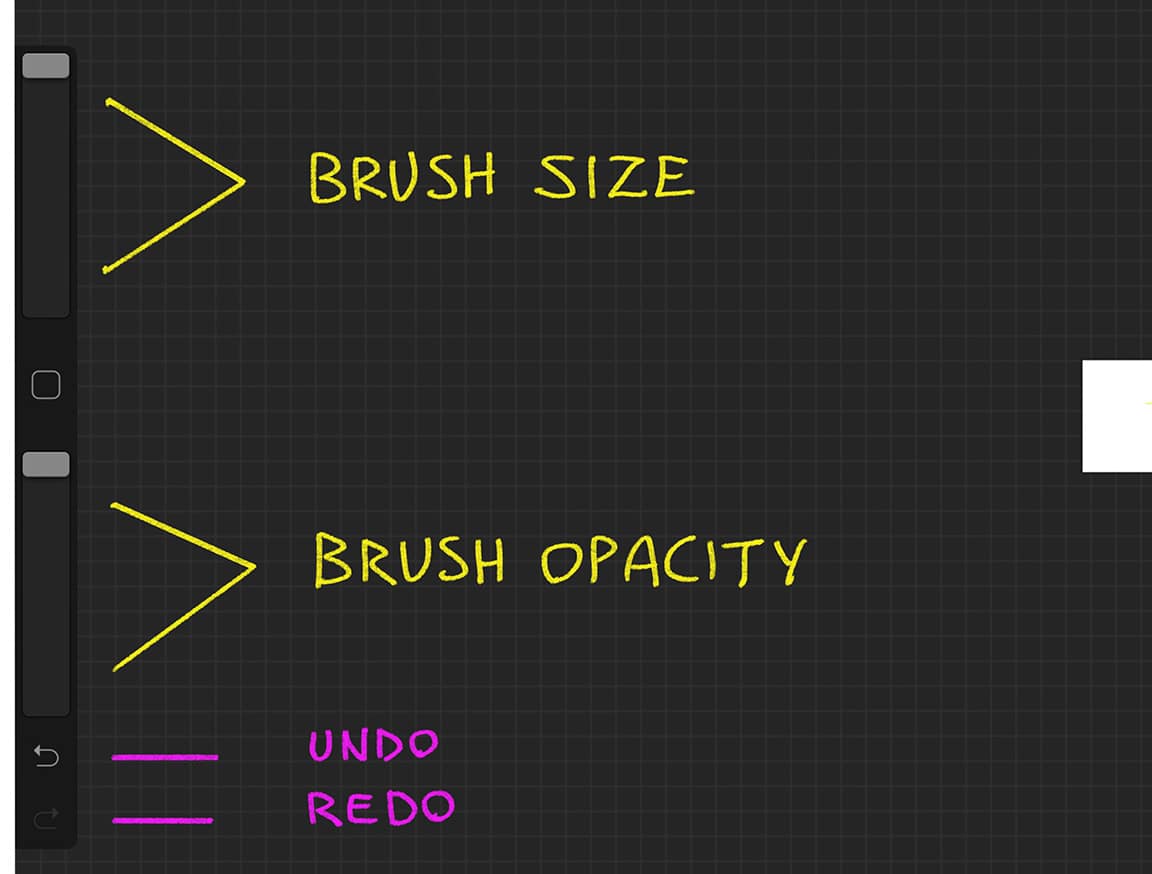
Then there are the slider toolbars on the left side of your canvas.
- Brush Size: The top slider. Tap, hold and move up and down to adjust the size of your brush tip. A preview window will open up to help guide you. This slider is used for your brush, smudge and eraser tools in the same way.
- Brush Opacity: The bottom slider. This works the same way as the brush size slider, but is for brush opacity.
- Undo/Redo: Under the sliders you’ll see these two buttons. Tapping the undo button will undo the last stroke you drew/erased. Vice versa with the redo button. This is a very useful tool you’ll probably use a lot. You can also undo by tapping once anywhere on your canvas with two fingers.
There is also the toolbar in the top left of your canvas. For these tools I will point them out and explain them along the way as we need them.
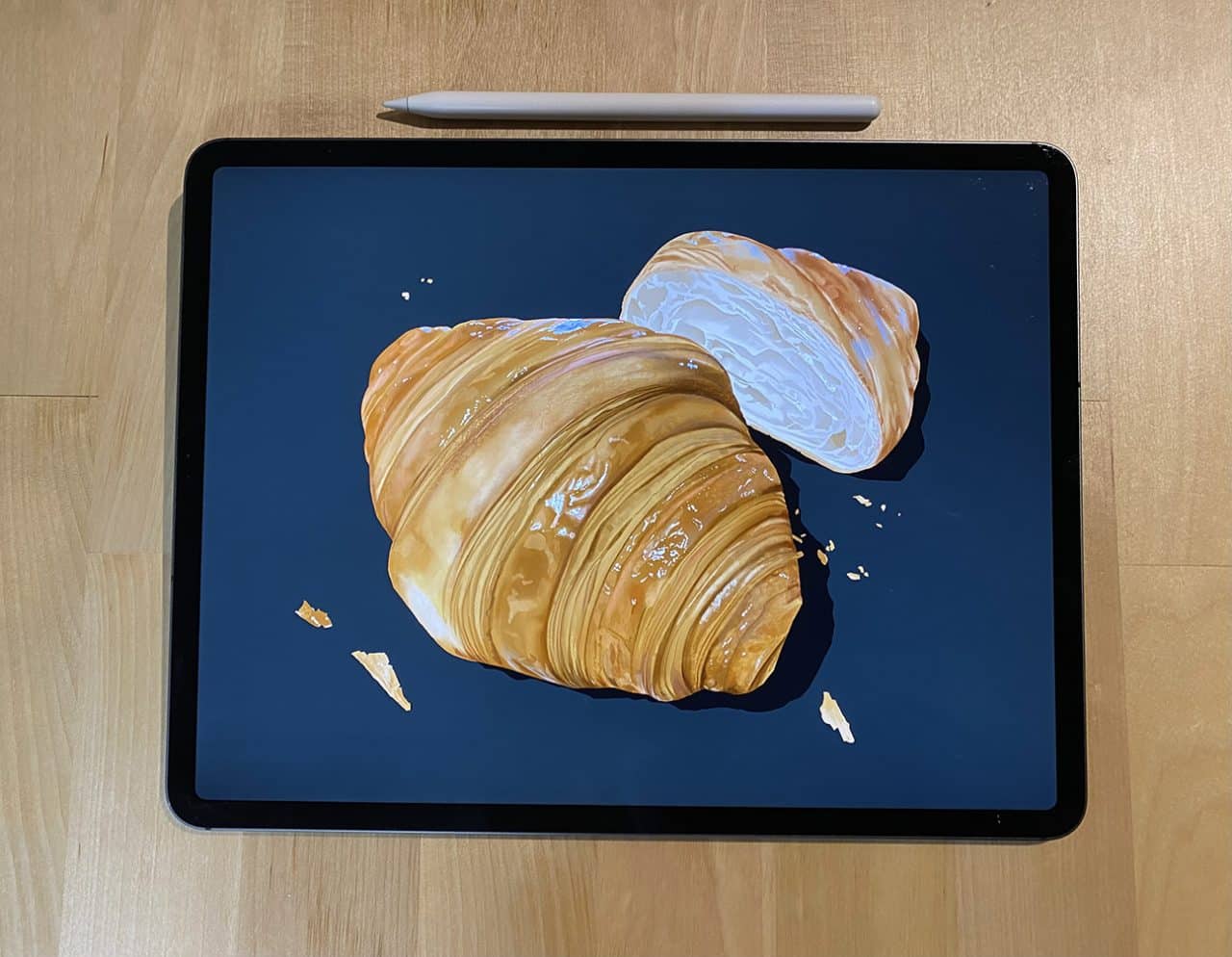
How to Draw Croissants Step One: Choosing a Reference Photo
If you can take your reference photo yourself, great. You can use the iPad itself to capture a good photo.
If you don’t have any croissants handy, I feel sorry for you. However, there are plenty of images online for you to choose from. It’s a good idea to chose one that is copyright free and there are several websites that have large libraries of free images.
I took my reference image myself in my kitchen. I normally place my item on my counter, however with my croissants being almost the same colour as my counter I chose to put them on a charcoal colouring plate as contrasting background. I cut one in half to expose the intricate interior, and made sure to leave some of the flakey crumbs (an unavoidable component of existing with a croissant).
I made sure to choose a spot where the light reflected the shininess of the croissant exterior. Make sure you get a nice, well-focused shot that is close up to capture all the small details.
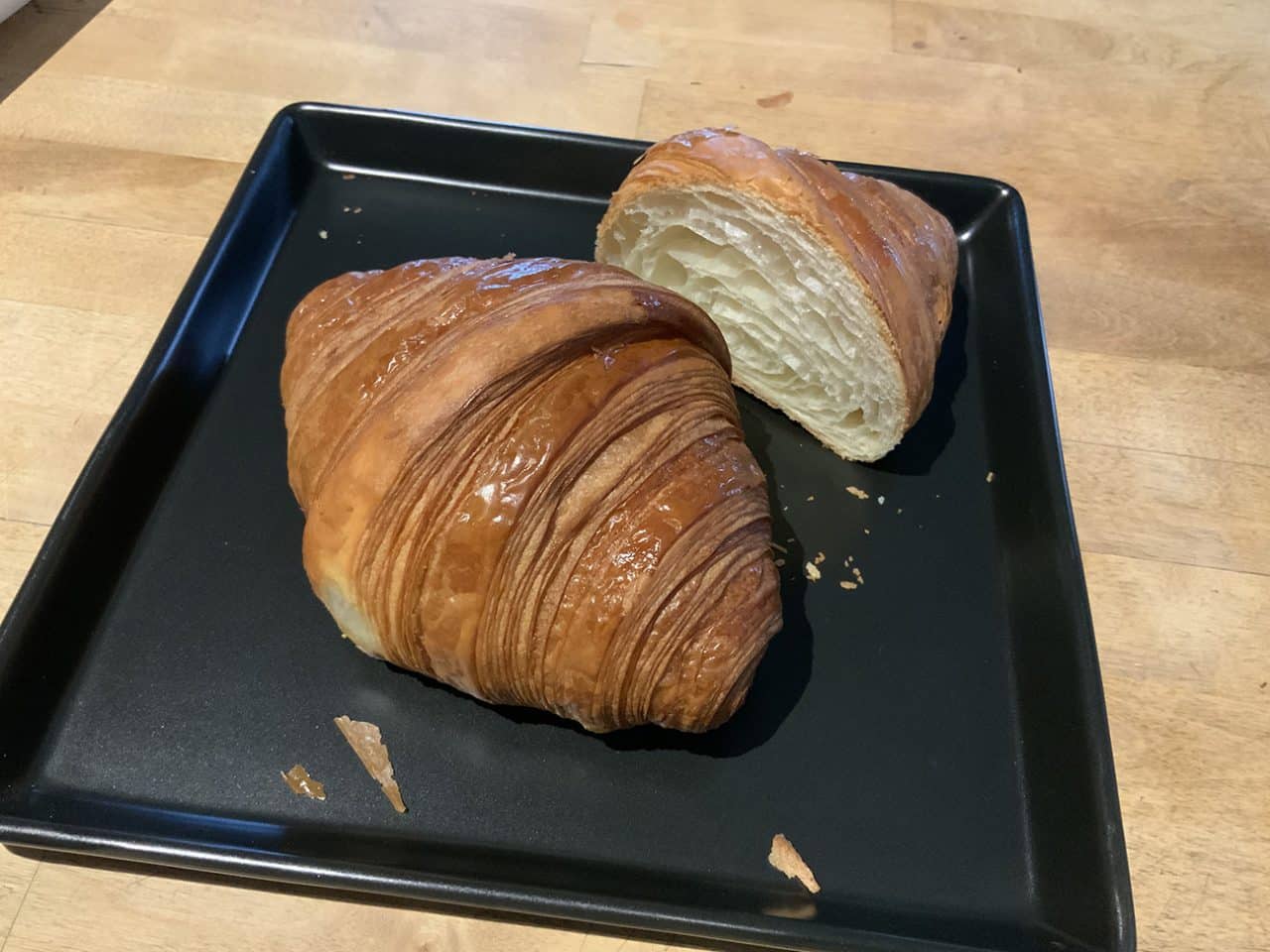
The first thing to do before you get to drawing is setting up your reference photo to work from. A great option with iPad Pro is that you can keep your photo open in a window beside your Procreate canvas while you work.
To do so, tap and hold the bar at the bottom centre of the screen in Procreate, then slowly pull up the iPad menu (if you swipe too quickly you’ll close Procreate).
Once the menu is up, tap and hold the photos icon, and drag it to the left side of the screen (or right side, for the lefties out there!) Pull it past the edge of the Procreate window and drop it there and tada, you have both open at the same time. You can also adjust the size of the photo window by holding and sliding the side bar of the window.

One additional thing I did this time around was to choose my background colour first. I really liked the look of my croissants on a dark background in my reference photo, so I wanted a similar colour in my drawing. Because it was a dark colour, I wanted it there as I drew so that I could see as I went how dark I needed my lowlights to be in my drawing. Just a little drawing tip that really works for me. Drawing while in “colour context” makes for a better looking finished product.
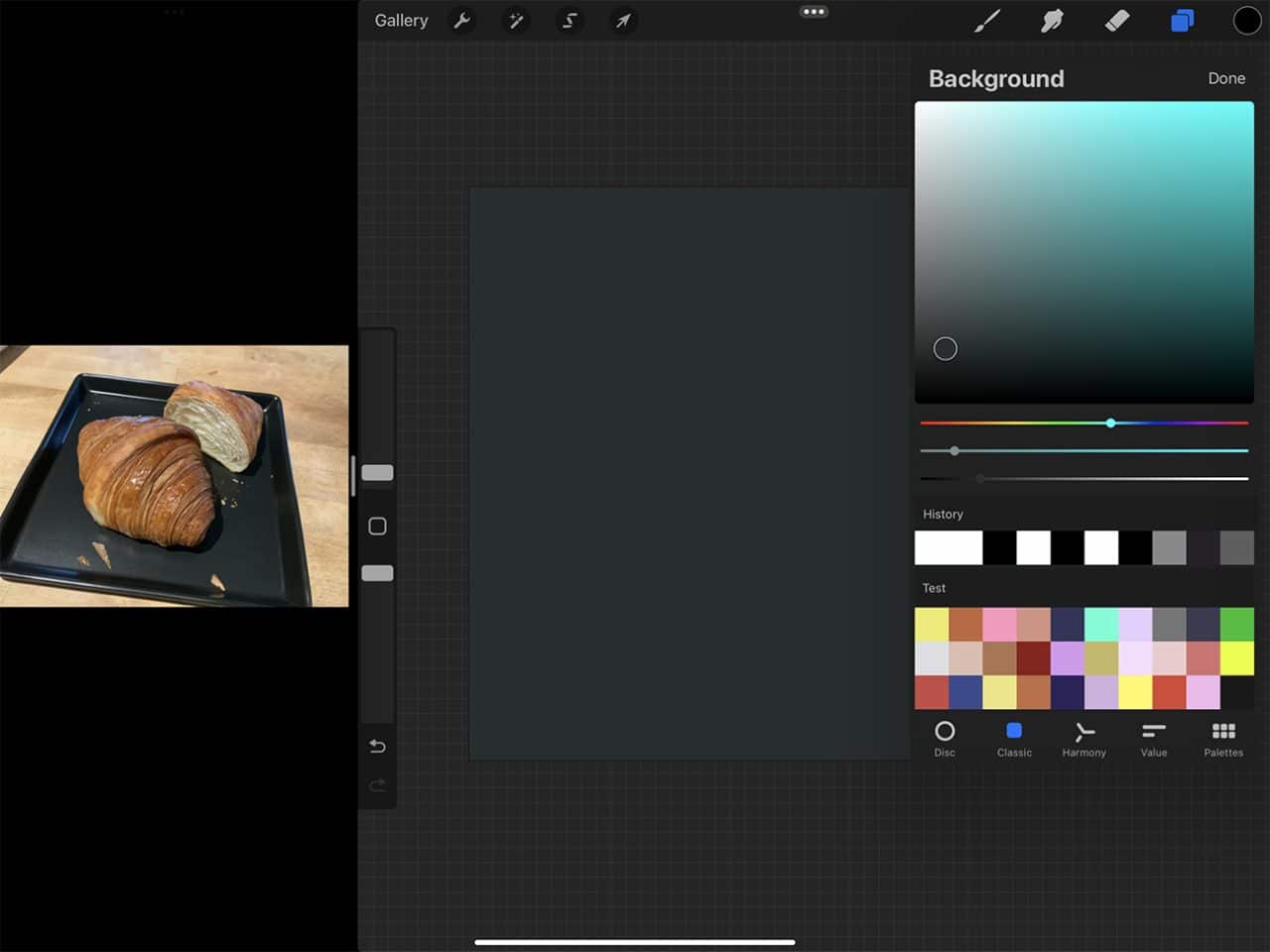
To select your background colour open the layers menu and tap the “background colour” layer. The colour palette will open and you can select your colour and adjust in real time on your canvas.
How to Draw Croissants Step Two: Blocking Your Shapes
Now you are set up to start drawing a croissant!
The first step will be blocking out the shapes of the individual pieces with a solid colour. For this I used the studio pen brush under “inking” in the brush menu, because it gives a nice clean line.
To determine which colour to use, I took a look at my croissant reference photo and tried to match it generally to the medium colour tone of each piece. A light brown/orange for the whole croissant, and a warm off white colour for the half croissant.
Once you have a fully enclosed shape, you can fill it in with solid colour by tapping and holding the colour icon in the top right, and then dragging it to the inside of your shape and releasing. The shape will then fill with that colour. Make sure your shape is fully enclosed or the “fill” will fill the entire canvas. If this happens just tap your canvas with 2 fingers to “undo.”
You will find it helpful to separate these shapes onto separate layers. This will make painting and editing them much easier down the road because you won’t have to worry about your painting bleeding from one clearly defined area to another.
To create a new layer tap the “layers” icon in the top right menu, and then tap the “+” in the drop down. You can tap and hold any layer in the menu and drag it above or below other layers.
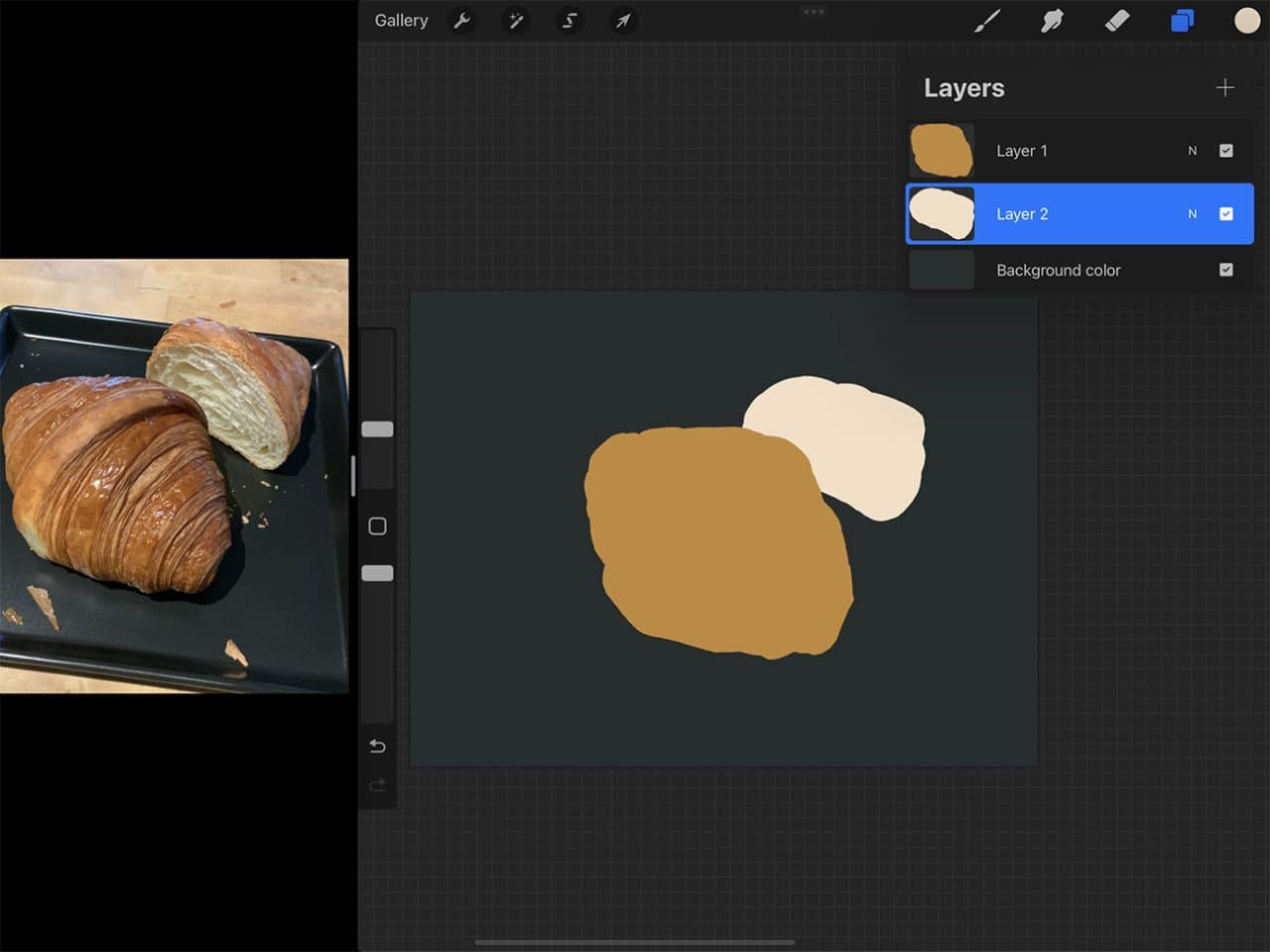
You can adjust the size and position of different elements in your blocked shapes by utilizing the “select” tool. That is the tool in the top left menu that looks like a cursor. Make sure the layer with the element you want to adjust is selected, and then tap the select tool. A bounding box will appear around the element with points you can tap, hold and drag to your liking.
You’ll see along the bottom that you also have several options for how to adjust your shape. You can play around with each to see how they work. For my drawing I was fine with my shapes, however I wanted them both to take up more of the canvas. To make them both bigger I used the “uniform” option.
To increase both of them at the same time I selected BOTH layers before I made my adjustment. To do so open the layers menu, tap the first layer you want to select, and then for any additional layers you can swipe them to the right with one finger. You’ll see each additional layer you include with be highlighted in blue. Then you can tap the select tool and both shapes will be included within the bounding box.

How to Draw A Croissant Step Three: Underlying Gradients
Now that you have your base layers of colour you can start “painting” and adding layers of colour to build up the 3-dimensionality and shape of your croissant. Take a good look at your reference photo and try to see the underlying gradients of light and dark tones beneath all of the finer details.
Before you begin though, Procreate has a feature that makes this painting and blending part a lot easier, called the alpha lock. If you “alpha lock” a layer, you can only paint on what already exists on that layer. Meaning when blending out some colours you don’t need to worry about your smudges coming past the edges of you blocked out shape.
To alpha lock a layer, open the layers menu. Using two fingers, swipe the layer you want to lock to the right. If you’ve done it successfully the layer thumbnail will get a checkered background. To un-lock the layer at any point simply swipe it with two fingers to the right again.
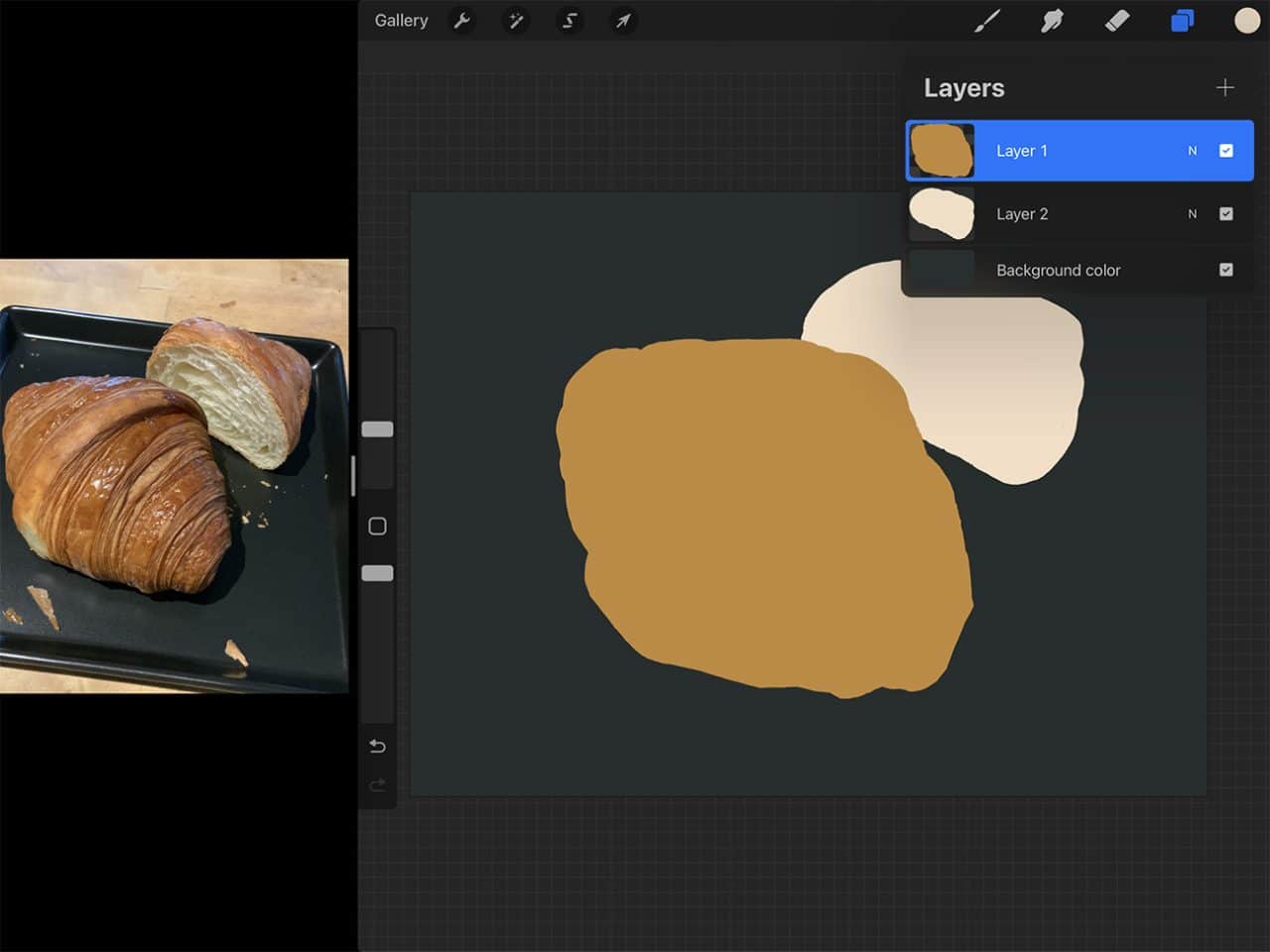
Now you can get to painting. For my drawing I started with the complete croissant. For this part you do not necessarily need to be very tidy with your painting. This part is about getting your colour tones down. For this part I chose the “gouache” brush under “painting” in the brush menu, but feel free to use whichever brush suits you.
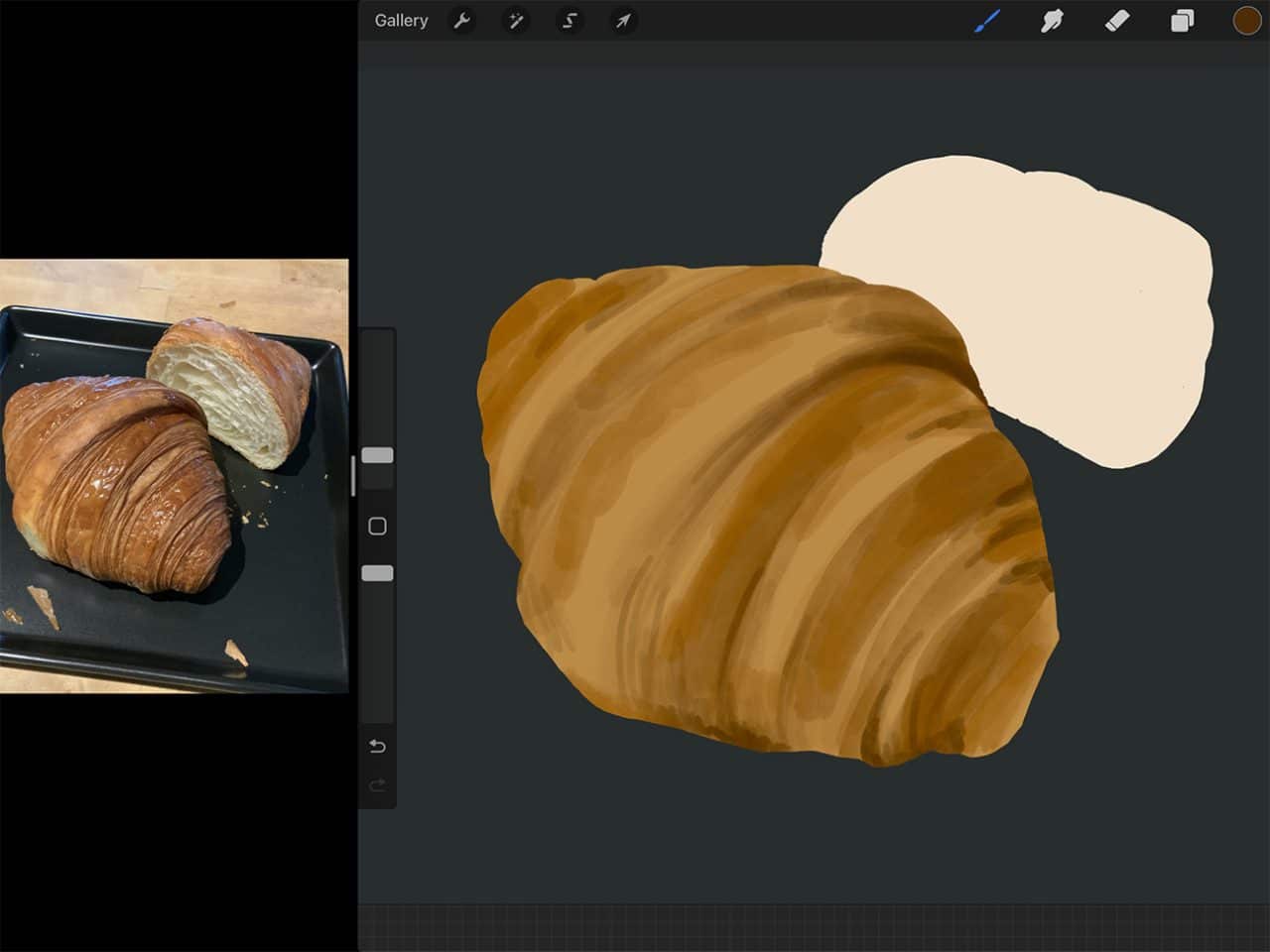
A croissant has a pretty distinctive structure and set of layers. There are a lot of details. However at this point you’ll be building up the light and dark. You can get finer and finer in your distinctions as you go, largely by decreasing your brush size. Take your time and build up the swirling layers, saving the very defined and crisp details for another layer.
Also pay close attention to your colours here. It is a good idea to zoom in nice and close on your reference photo in order to really become aware of the different colours that reside in your subject. I was actually surprised that along the top of my croissant were a lot of pink and blue tones. Pretty unique and somewhat counter-intuitive!
How to Draw Croissant Step Four: Blend and Adjust
After you have your general rough painting down, it’s time to smooth it out and blend your colours where need be. For this you will use the smudge tool in the top right menu. For the smudge “brush” I also chose the gouache brush just to match the paint strokes.
Go ahead and blend where you need to in order to get the right kind of transitions between areas of different colour. Keep in mind it is possible to overblend! You want the transition between different colours to be smooth but still defined. To undo any stroke remember you can tap the canvas anywhere with two fingers to undo your strokes.
It make take some time to find the right balance with this. You can switch back and forth between the blend tool and painting over it again until you come to the right appearance.
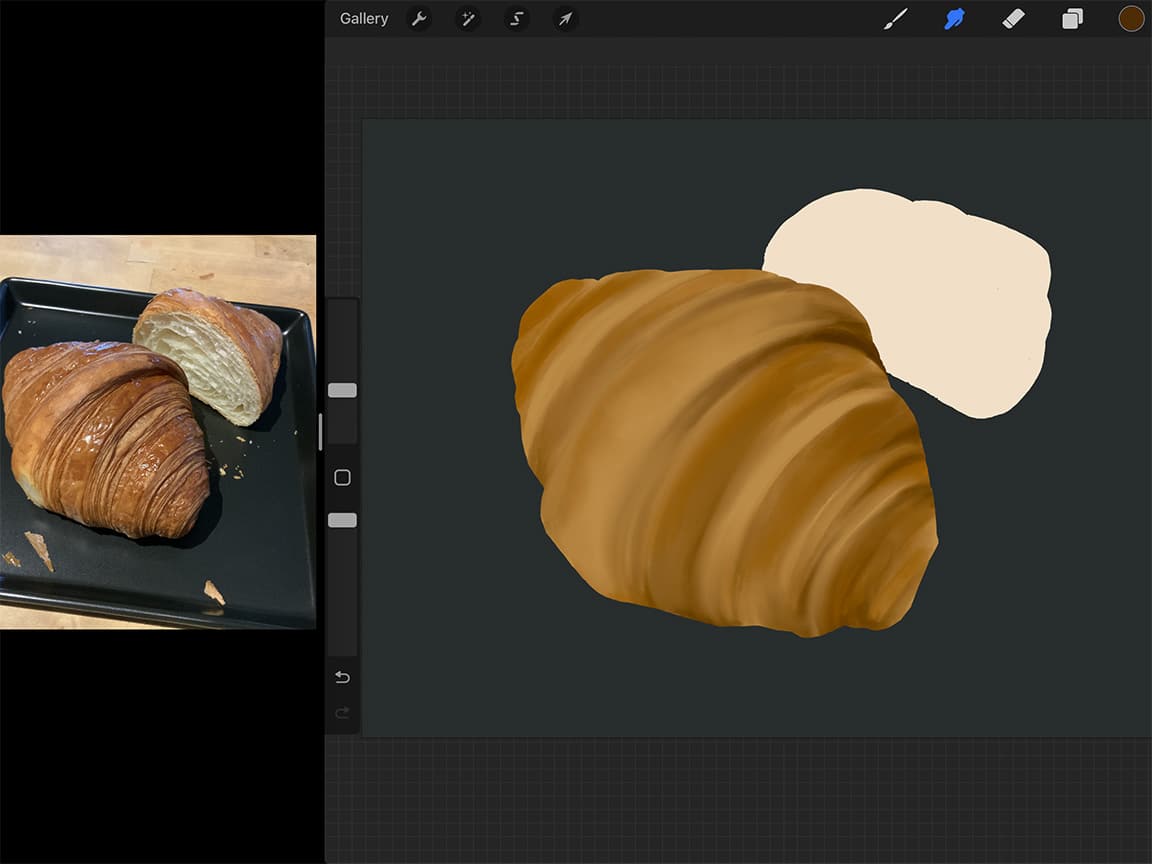
How to Draw A Croissant Step Five: Highlights and Details
Now that you have your basic shape down it’s time to add the highlights and details that will really bring your drawing to life. For these it will be helpful to do them again on a separate layer. This way when editing you won’t ruin any of your careful painting and blending of your underlying gradients.
The first detail I added were some of the thin and clear lines that make up the edges of the crispy layers of dough on the outside of a croissant. This ends up looking like long lines with areas that widen out here and there.
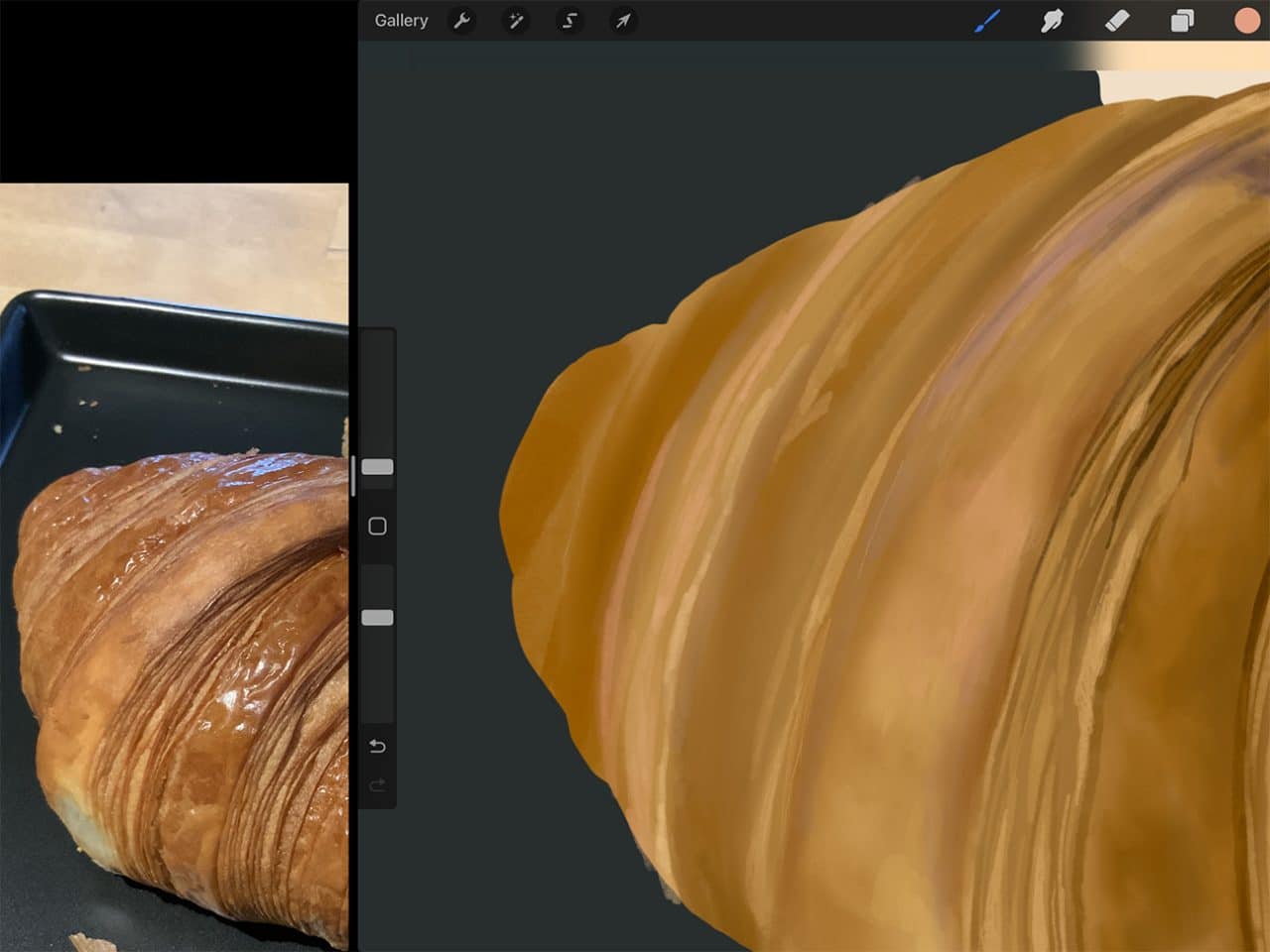
The details are complicated, it may be easy to get confused trying to exactly replicate what you see in your picture. Just do your best and after a bit of drawing you’ll just get the general knack of what the lines and structure look like. Then you can get away with a some drawing that on your own rather than copying and will still get a realistic looking result.
Pay attention to where things get dark and adjust your colours accordingly. For this step I mostly still used the gouache brush, just at a very small size, but perhaps you’ll find it easier to get the look you want by experimenting with different brushes.
Zoom in to work but zoom out often just to see if you are getting your desired result. Don’t be discouraged if it takes a while to get things just right. A croissant is a challenging thing to draw!
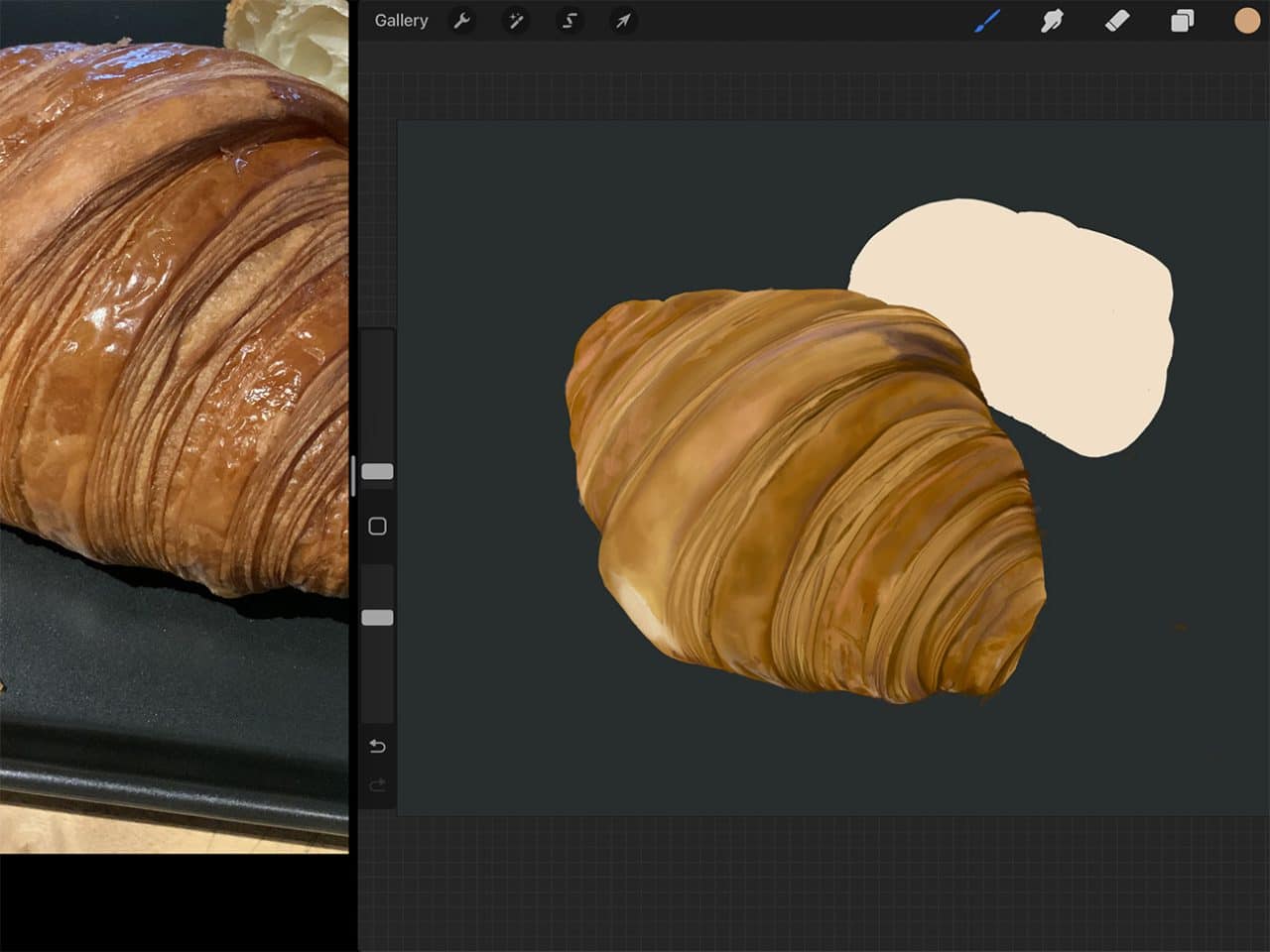
How to Draw A Croissant Step Six: Finest Details and Shine
Now we can move on to the final touches of the whole croissant that will really bring it to life. Namely, the shine points. Definitely do this on a separate layer again. Zoom in nice and close and recreate those super bright shine points. My tip here is to build up the shine points slightly. The brightest spots are quite sharp and defined, but there is a bit of a “glow” underneath them. Use a not-quite-white colour to create this glow, and then add the true white patches on top. For those I used the “technical pen” brush under “inking” for that crisp defined shape.
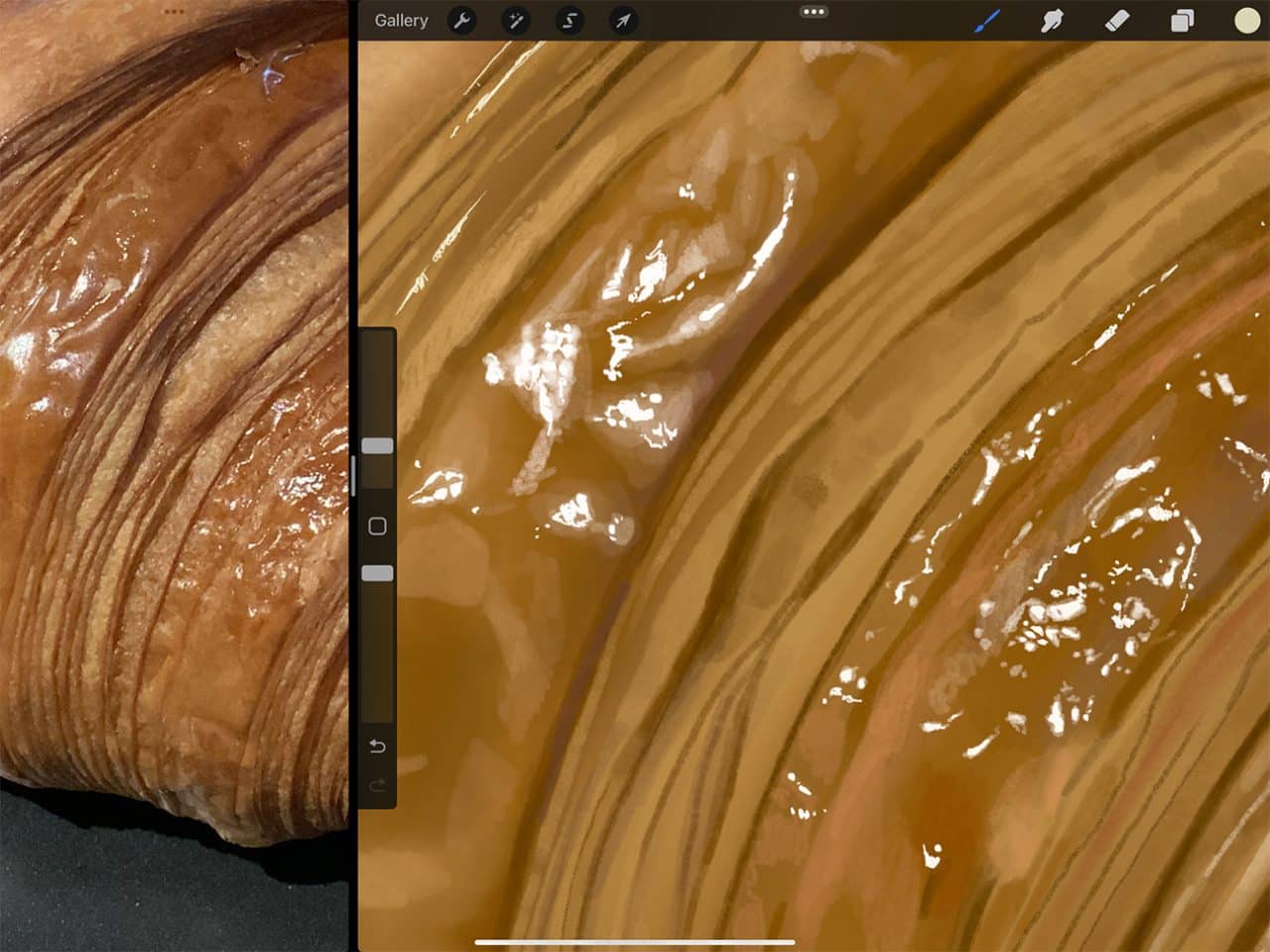
Other finishing detail I noticed I needed was some more texture on the centre strip of dough in the centre of the croissant. There is a distinct look there that I know was created by the baking process, and I found I could best recreate that texture by using a different brush.
Because this area has a very defined edge, I used a painting trick with the “lasso tool” whereby I isolated just that portion of the shape to draw on. To do this, tap the lasso tool which is in the top left menu, right beside the cursor tool. It looks like an “S.” Then draw around the portion of the shape you want to draw on.
Once you have finished your shape tap the brush tool in the top right menu and everything you haven’t drawn around will be blocked out on your canvas with diagonal lines. And voila, you have your isolated area to paint on.
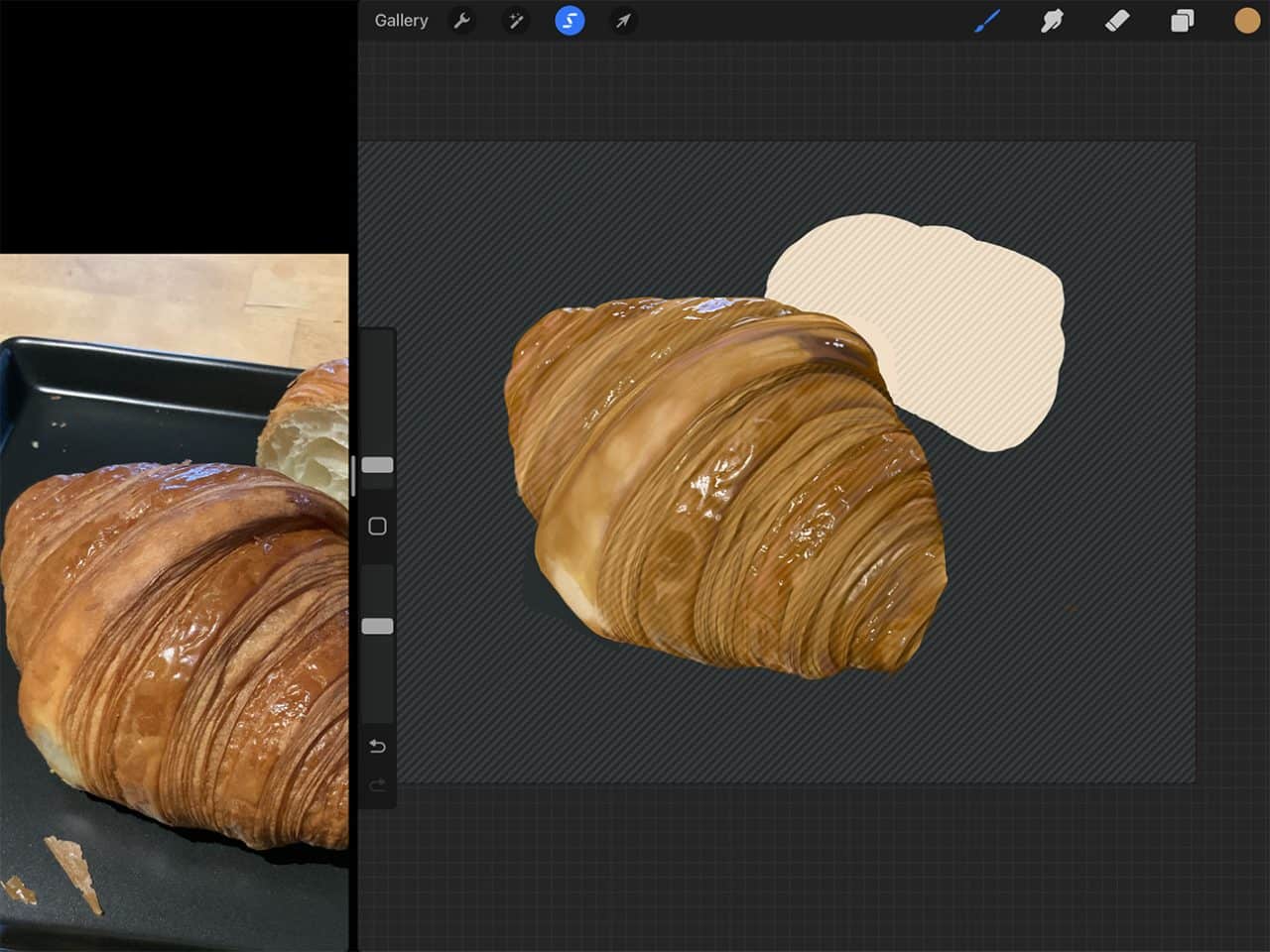
I selected the “stucco” brush under “painting” and increased the brush size quite a bit. I lightly painted over with a couple of strokes using a darker brown colour and was able to get that slightly “toasted” look.
You may find this method will be helpful in other parts of your drawing if you want to have nice clean edges.
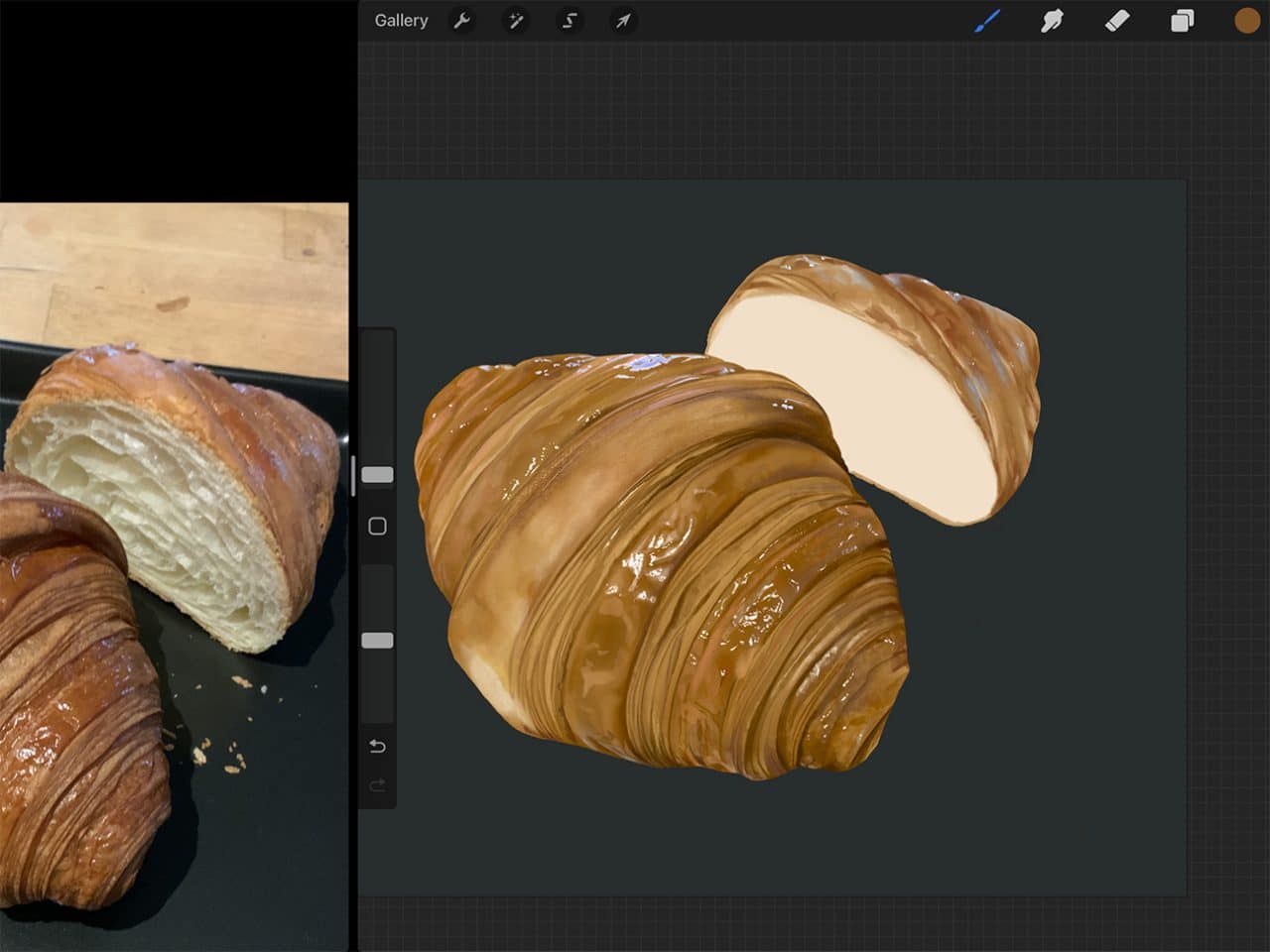
Now that you’ve got your whole croissant finished you can draw out the “crust” of your half croissant using the same step by step process as above.
Normally I might suggest using the lasso tool drawing trick again to separate the edge of the crust from the croissant interior. However, this edge is not very clean and crisp, so I don’t think it’s necessary here.
How to Draw Croissants Step Seven: Croissant Interior
Just as you’ve figured out and finished the complex exterior of your croissant, we move on to the interior, which is also very complicated, but in a totally different way – hooray! I actually found this part much easier that the exterior, because when broken down, it’s a lot simpler than it looks.
Start by looking at the “holes” that make up the telltale interior structure of a croissant. They themselves have small gradients within them, however for this first part think of them as solid shapes. Choose a colour slightly darker than the existing interior colour and draw out all the shapes you see with a clean-edged brush like the technical pen.
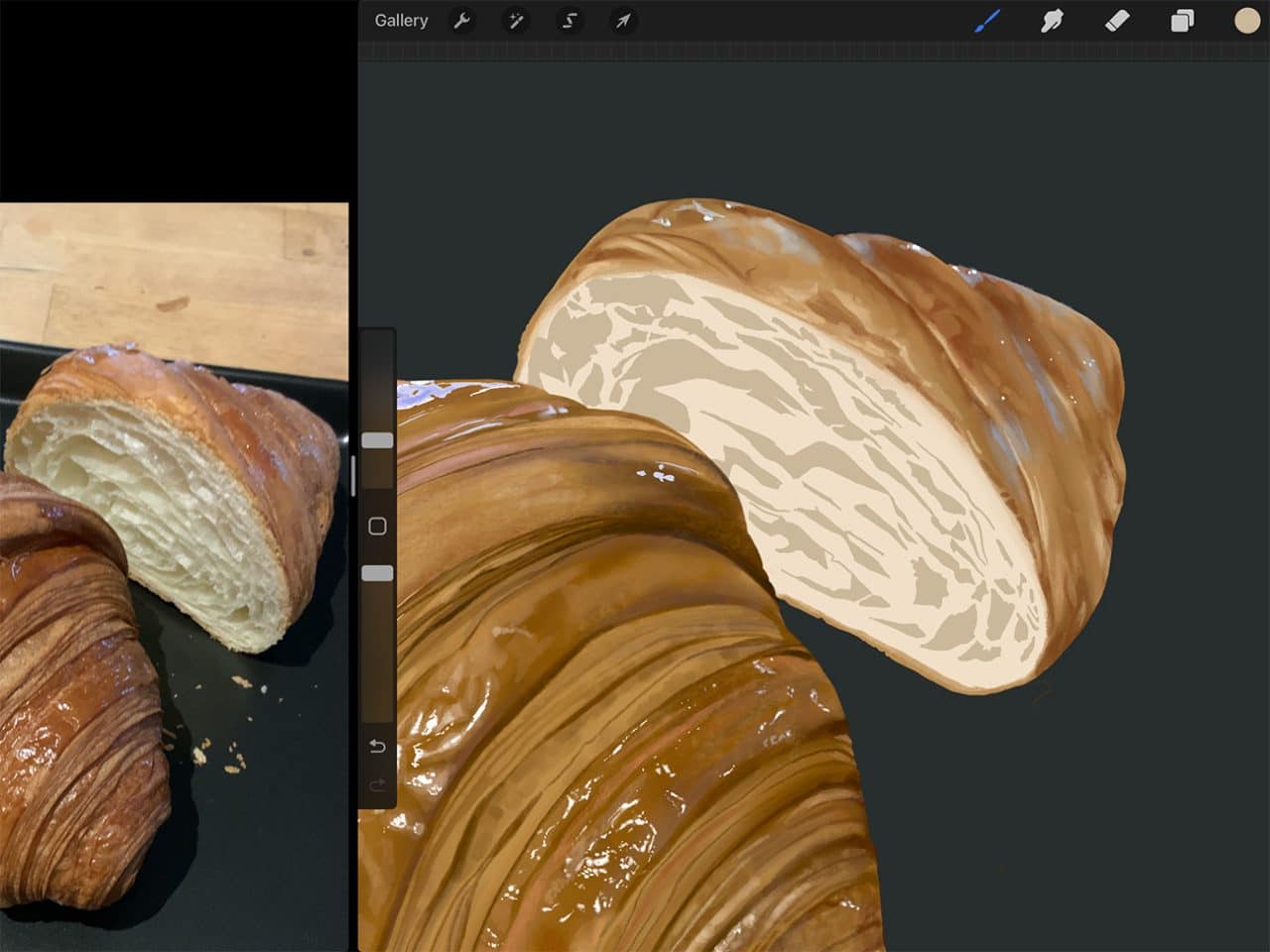
Next you can go in and use your smudge tool to blend out areas that have a smooth transition to the lighter background colour. Shrink your smudge brush size down accordingly.
The final step here is to go in and excentuate the depth of the holes by adding low-lights. For this part it will be easiest to once again, alpha lock this layer to keep your darkening within the clean edges.
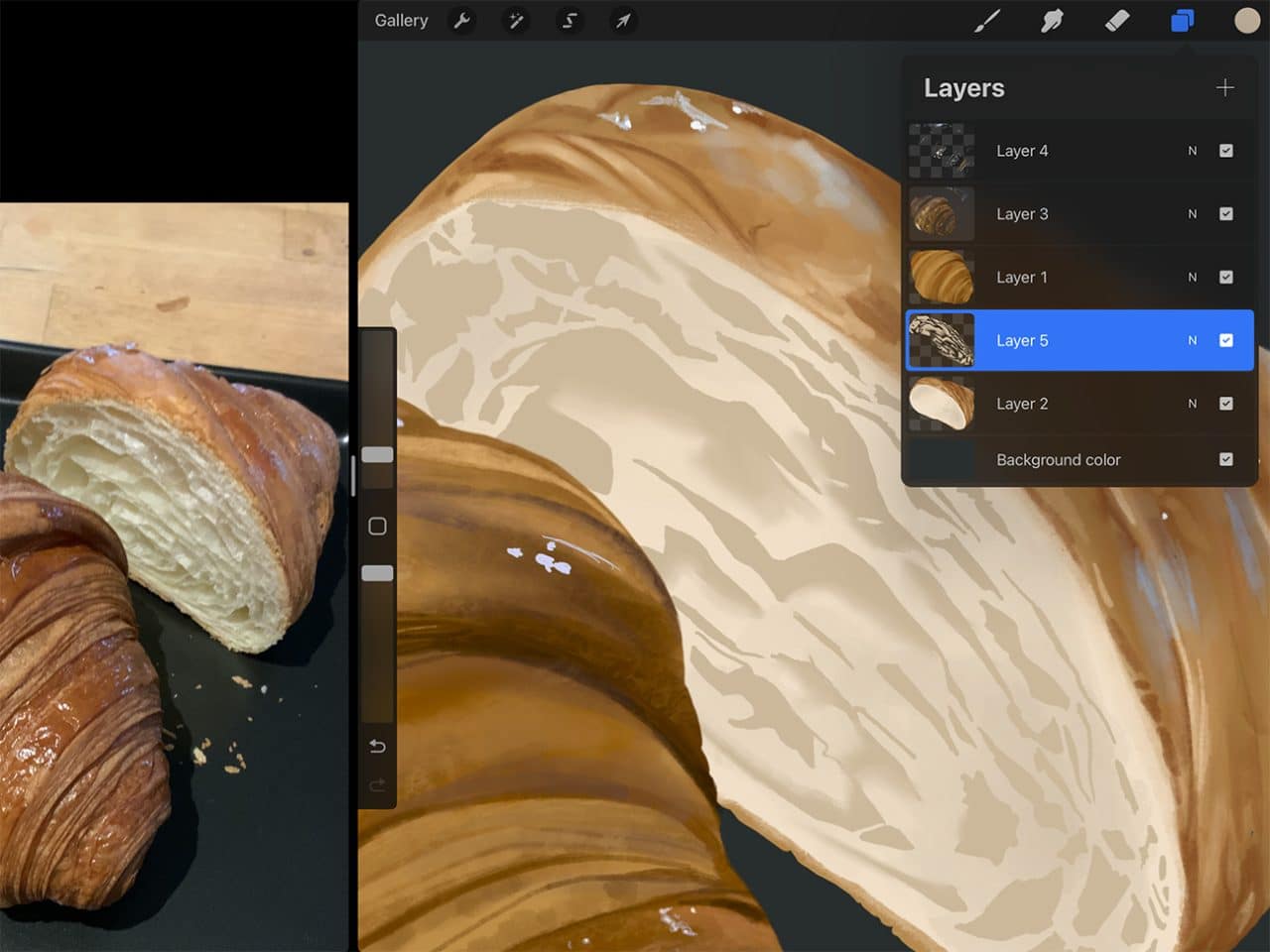
How to Draw Croissants Step Eight: Shadows and Crumbs
Finally, to complete the drawing I added some shadows to ground the croissants.
To do your shadows, start on a new layer positioned below the croissant layers. Draw out your shadow shapes with a clean-edged brush (like the studio pen) and fill them in with a dark, nearly black shade of your background colour. Then you can use the layer’s opacity to make them slightly transparent to let the background colour come through.
To do so, open the layers menu, then tap the “N” on the shadow layer. Then you can adjust the slider to the transparency of your liking.
And voila! Your finishing touch is done.
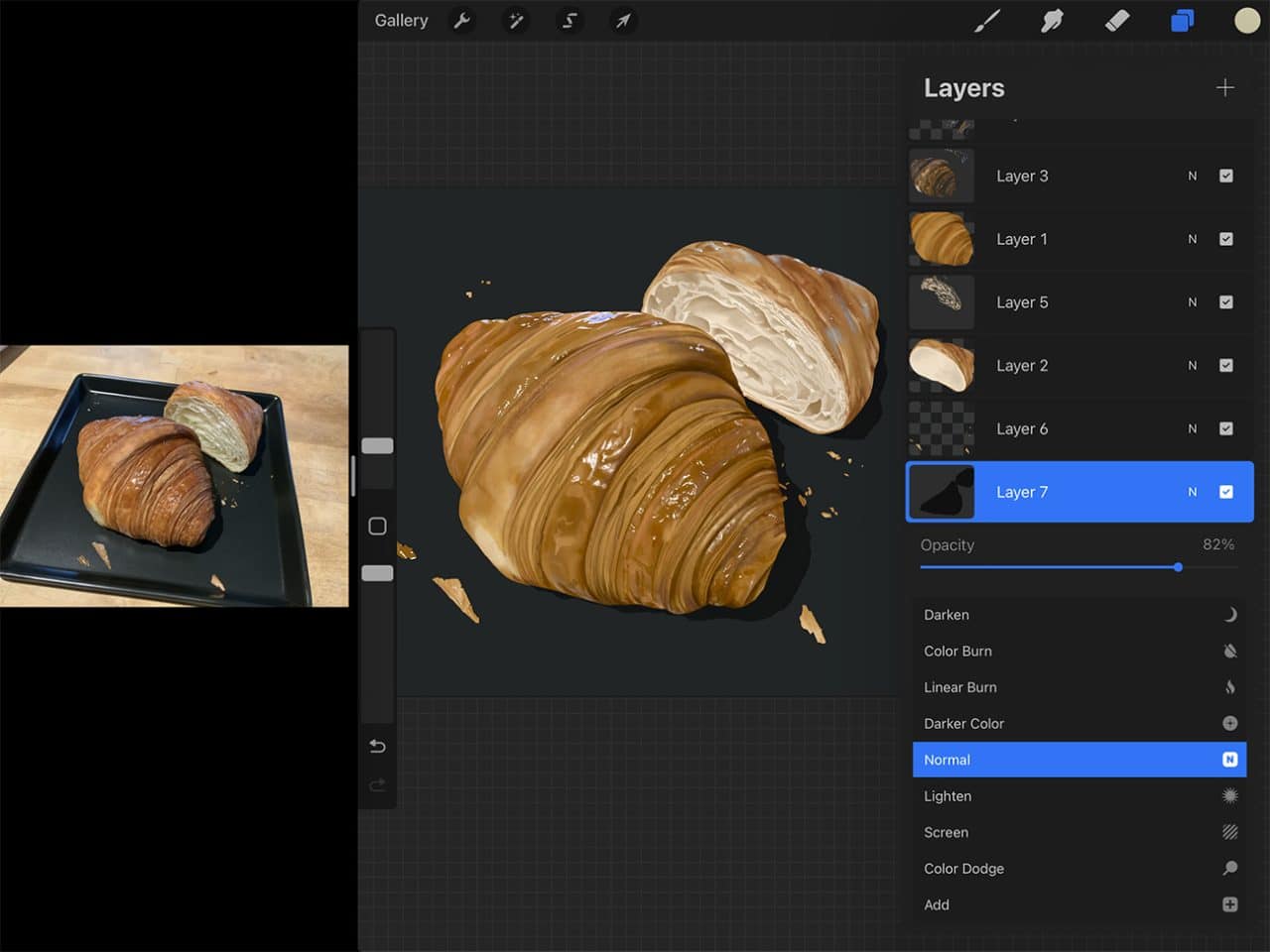
Helpful tips:
- Give your canvas and/or your reference photo more space if needed by dragging the slider in between the two windows. You’ll see a grey bar to tap on, hold and slide.
- You can zoom in and out by “pinching” the screen with two fingers. Don’t forget you can zoom in for areas with small details. You can also rotate the canvas using the two-finger pinch (rather than turning the iPad itself around, an inevitable habit when you’re used to turning your piece of paper around – there is an easier way!
You May Also Enjoy Reading…
- How to Draw Squash
- How to Draw Capsicums
- How to Draw Onions
- How to Draw Strawberries
- How To Draw Grapes
- How To Draw Blueberries
- How To Draw Carrots
- How To Draw Pears
- How To Draw A Broccoli
- How To Draw a Lemon
- How To Draw A Candle
- How To Draw Tomatoes
- How To Draw an Orange
- How To Draw Potatoes
- How To Draw Fish
- How To Draw Mountains
- How To Draw A Cottage
- How To Draw A Bottle
- How To Draw Shoes
- How To Draw Realistic Animals
- How To Start a Vlog: Purchase the Best Equipment for Vlogging
You’ve Completed our Realistic Croissant Drawing Tutorial!
You’ve now mastered how to draw a croissant!
If you’re someone who draws or paints a lot, you know it’s possible to keep going and going and tweaking and tweaking into eternity. And truthfully Procreate makes falling into this even easier.
The up side, however, is that you can leave the piece alone for a time, and then very easily pick up where you left off, without having to get all of your paint and supplies out.
All that said, you will know when it’s done, and for a satisfying finish to your digital drawing experience, you can utilize one of my favourite Procreate features – time lapse video.
By default, Procreate records your entire drawing process (you can opt to turn this off, but really why?) You can play it all back in high speed when your drawing is complete. It’s a fun thing to watch and a fantastic thing to share with curious fans of your art.
If you’re a freelance illustrator, find that offering a time lapse video of your clients’ work acts as a competitive advantage. And better yet, offering a video that showcases the creation of your croissant drawing requires no additional time or money.
By using this Procreate tutorial as your step-by-step drawing guide for how to draw croissants, I’m sure you will be very satisfied with your result. Once you’ve gone through the motions from start to finish you can experiment and settle into your own process.
This medium has so many possibilities that you can really let your creativity run wild. So dive in, go digital and have fun!
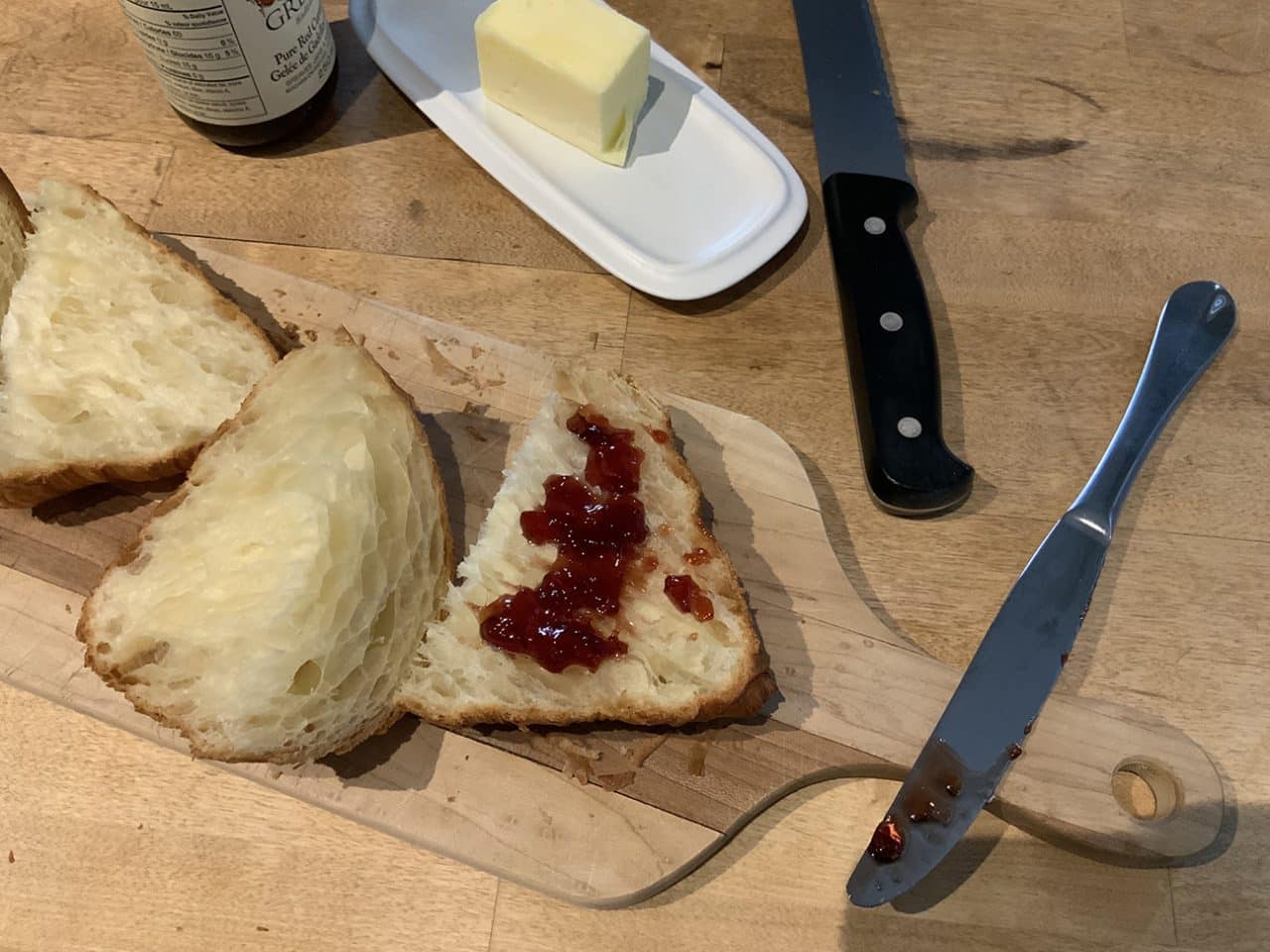
Best Illustration Apps
This story offers a step-by-step Procreate tutorial on how to draw a croissant. It’s important to note that there are several other drawing apps you can use on iPad Pro when drawing croissants. Here are just a few:
- Notes: The Apple sketch app that comes with your iPad! Simple, easy to use for quick sketches, free and fast. Though for serious drawing you may want to seek apps with more robust options/tools. Price: FREE
- Adobe Illustrator Draw: This app is for creating vector graphics, with a very intuitive interface. It can also sync with Adobe’s Creative Cloud, meaning you can transfer your work between the iPad and desktop no problem. Price: FREE with Creative Cloud subscription, monthly plan prices vary.
- Inspire: Fast and nicely responsive, with a huge variety of customizable tools, and over 80 brushes. Great for beginners and intermediates alike. Price:$13.99 CAD, $27.99 for Pro Version.
- Procreate: Easily one of the most popular drawing apps, it works seamlessly with Apple Pencil, is highly responsive and offers an excellent variety of tools, all presented in a terrifically simple interface. Price: $13.99 CAD
If you’re a newbie digital illustrator we also suggest purchasing Beginners Guide to Digital Painting in Procreate, iPad and iPad Pro for Dummies, a protective iPad cover and Apple Pencil Case.
Procreate Tutorial: The Benefits of iPad Pro
- The process is very similar to drawing using traditional methods on paper. You’ll be delighted by how intuitive it is, and how for the actual drawing part, you don’t need to re-learn anything.
- Streamlined process. All of your supplies – camera, reference photos, paper, pens, pencils, eraser, pencil sharpener, paint and paint brushes, are all combined into one place – iPad Pro and the Apple Pencil.
- The ability to undo when your pen stroke wasn’t quite right. You can also edit certain elements after the fact. The thickness of that piece is too much, I don’t quite like the colour I used here. All of that can be fixed!
- The ability to work in layers, drawing or colouring over or under certain elements without worrying about accidental erasing or colour contamination.
- You aren’t tethered to your desk, you can get comfy and work wherever you like. And that includes outside your own home too.
- Easy transferability/shareability of your art. Your finished product is already in a format that you can add to your illustration portfolio online, share on your social media, etc. No need to arrange a high quality scan or professional photograph.
- The ability to replicate elements, (for patterning, for example) rather than needing to hand-draw the same thing over and over.
If you’re a freelance illustrator looking to up your game, getting familiar with this medium will benefit you tremendously. And if you are an amateur who just loves to draw, looking to have fun creating croissanth or other still life drawings, iPad Pro and Apple Pencil can help you do things you might not have thought possible.
Some of the links in this story use affiliate links. This means that if you make a purchase through our site, Dobbernationloves will earn a small commission at no extra cost to you. Your support helps us to produce comprehensive content.

